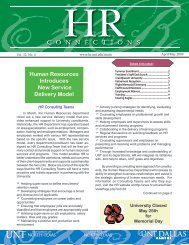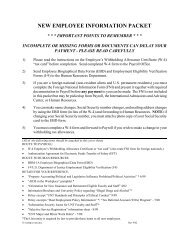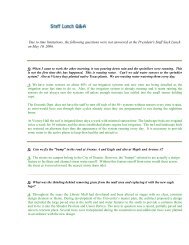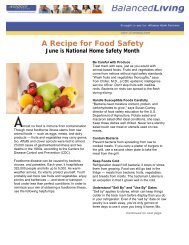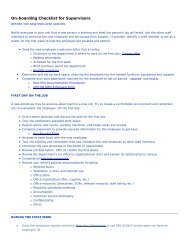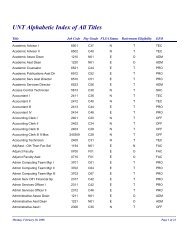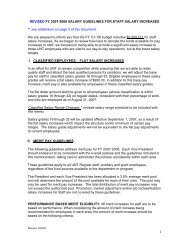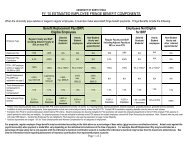Workplace Safety
Workplace Safety
Workplace Safety
Create successful ePaper yourself
Turn your PDF publications into a flip-book with our unique Google optimized e-Paper software.
<strong>Workplace</strong> <strong>Safety</strong>WORKERS’ COMPENSATION INJURIES COST MULTI-MILLIONSOF DOLLARS IN ANY GIVEN FISCAL YEAR. DEMONSTRATEDMANAGEMENT SUPPORT OF SAFETY IS CRUCIAL IN REDUCINGTHESE COSTS.<strong>Workplace</strong> safety affects everyone, but particularly those in leadership roles who are responsiblefor the safety of their colleagues and office spaces. Work practices are particularly important; theway an individual performs his job is a combination of both learned behaviors and workplace habits.Managers and supervisors are responsible for leading by example and setting the tone to ensureall of their employees are implementing safe work practices.Office ErgonomicsSlips, Trips & FallsBack <strong>Safety</strong>Fire PreventionElectrical <strong>Safety</strong>General <strong>Safety</strong> &HousekeepingPhysical comfort and health enable you to focus more onthe job at hand, as well as increase your productivity.Office ErgonomicsDue to the repetitive nature of many work functions, the wear and tear of those movements on muscles and joints canincrease an individual’s risk of developing a musculoskeletal disorder. There are several ways to reduce these risks: Change positions and stretch your fingers, hands, arms and torso periodically. For every 20—30 minutes of work, try to take a 20-secondstretching break. These brief breaks help your body to recover and reduce fatigue. Your chair should be adjusted to the proper height, keeping your body and legs at 90° angles. Both feet should be flat on the floor or footrestand a lumbar support should be used for back support. Hands, wrists and forearms should be at 90° angles. Frequently used items, such as the telephone, should be within arms’ reach. Neverrest the telephone on your shoulder. Arrange your computer to minimize awkward body positions. Adjust your monitor so that you don’t have to strain your neck or eyes tolook at the screen and to minimize glare. Keep your fingers slightly curved when using your keyboard and do not use your armrests whiletyping or using your mouse.Read more
Slips, Trips & FallsSlips, trips and falls account for the majority ofworkers’ compensation injuries, but they’re the easiestto prevent. There are several ways to reduce risk: Place moisture-absorbent mats in entrance areas, particularlyduring inclement weather. Have wet floor signs readily available.Clean up spills or puddles right away. Aisles and hallways are not extended storage spaces: keep them cleanto eliminate tripping and fire hazards. Close file cabinet drawers after use and do not store items on the flooraround your desk. Don’t stand on chairs to retrieve items—always use a ladder or stepstool. Maintain proper lighting by replacing light bulbs when they burn out. When carrying a large item or load, make sure you can see above andaround it. Wear foot wear appropriate for your job duties. If your duties includeexposure to glass, chemicals or hot materials, do not wear open-toedshoes. Similarly, if your duties include lifting or carrying objectsweighing more than 15 pounds, wear safety shoes. Always be aware of what is happening around you: watch whereyou’re walking, both around your office and around campus.Fire <strong>Safety</strong>Office fires are often caused by carelessness and canspread quickly due to open floor plans, the prevalenceof paper and other flammables, and poor housekeepinghabits. There are several ways to reduce these risks: Keep your office/workspace clean and clutter-free. Fires spread morequickly in cluttered areas, and the more cluttered a workspace is, themore difficult it is for medical personnel to help you in the case of anemergency. Do not use candles, candle warmers or plug in air fresheners in theworkplace. Not only can these items start an office fire, but the fragrancecan also trigger an allergic reaction for some individuals. Do not leave food unattended in a microwave or toaster oven. Unplugappliances when not in use. Shelves and materials should be at least 18 inches away from sprinklerheads. Exits, stairways, doorways and hallways need to be unblocked at alltimes. In the event of a fire, call 911. Pull the alarm and leave the buildingimmediately. Know your primary and secondary emergency exits, aswell as your building’s meeting point per UNT’s Emergency ManagementEvacuation maps. Do not use a fire extinguisher or try to rescueothers without proper training.Back <strong>Safety</strong>The back is vital to most movements, but it is not veryresilient. Even a small injury can weaken your backand result in lifelong pain and discomfort. There areseveral ways to reduce these risks: Lift with your knees, not your back. Keep the object close to yourwaist; do not twist your body and keep your movements slow andsmooth. Make sure you can see around the object. Don’t store heavy items on top shelves. Instead, store them on middleshelves where they can be retrieved more easily. If an item is too heavy, ask someone for help or push/pull the objecton a dolly. Do not slouch at your desk—this adds pressure to your back. Stretchperiodically throughout the day to keep your back strong and flexible. If you stand for extended periods, place one foot on a footrest to reducepressure on your back.Electrical <strong>Safety</strong>Electricity is essential to many work functions, but canalso lead to electrocution and electrical fires There areseveral ways to reduce these risks: Check cords regularly for frays and tangles. If necessary, use power strips in your office. Never plug one powerstrip into another power strip. Power cords should never cross walkways or aisles. Not only is this atripping hazard, but the more a cord is walked or rolled over, the morequickly it becomes frayed. If you must use and extension cord temporarily,tape it down. Avoid using space heaters. Instead, contact Facilities for temperatureadjustments in your office. If space heaters are a necessity, they must be plugged into a wall socket,not a power strip. All space heaters must be inspected and approvedby UNT Risk Management and meet the following requirements: Electrical with a 1500 Watts maximum UL listed Top-over cut-off protection Do not block electrical breaker panels.General <strong>Safety</strong> & HousekeepingDue to the repetitive nature of many work functions, the wear and tear of those movements on muscles and joints canincrease an individual’s risk of developing a musculoskeletal disorder. There are several ways to reduce these risks: Know where the First Aid kit and Automated External Defibrillator (AED) are located in your building, as well as who is trained to use these items. Avoid making filing cabinets top heavy. Keep the bottom drawer full or bolt the cabinet to a wall or floor. Don’t store items on top of filing cabinets.Don’t open more than one drawer at a time. If the copier/printer is broken, don’t try to fix it yourself. Use cups or bottles with lids. Open containers can spill and create a slipping hazard, damage a computer, or create an electrical hazard. Do not block ventilation grates with filing cabinets or other furniture.



